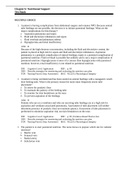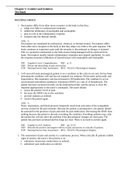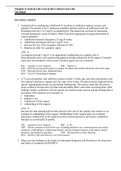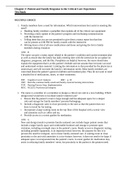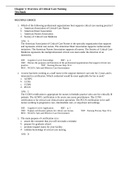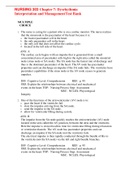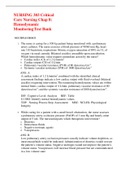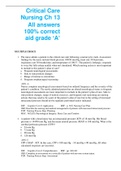Minnesota School Of Business
Latest uploads at Minnesota School Of Business. Looking for notes at Minnesota School Of Business? We have lots of notes, study guides and study notes available for your school.
-
59
- 0
-
4
All courses for Minnesota School Of Business
Latest notes & summaries Minnesota School Of Business
1. A patient is having complications from abdominal surgery and remains NPO. Because enteral tube feedings are not possible, the decision is to initiate parenteral feedings. What are the major complications for this therapy? a. Aspiration pneumonia and sepsis b. Fluid and electrolyte imbalances and sepsis c. Fluid overload and pulmonary edema d. Hypoglycemia and renal insufficiency ANS: B Because of the high dextrose concentration, including the fluid and electrolyte content, the patien...
1. Nociceptors differ from other nerve receptors in the body in that they: a. adapt very little to continual pain response. b. inhibit the infiltration of neutrophils and eosinophils. c. play no role in the inflammatory response. d. transmit only the thermal stimuli. ANS: A Nociceptors are stimulated by mechanical, chemical, or thermal stimuli. Nociceptors differ from other nerve receptors in the body in that they adapt very little to the pain response. The body continues to experience p...
1. A patient who is undergoing withdrawal of mechanical ventilation appears anxious and agitated. The patient is on a continuous morphine infusion and has an additional order for lorazepam (Ativan) 1 to 2 mg IV as needed (prn). The patient has received no lorazepam (Ativan) during this course of illness. What is the most appropriate nursing intervention to control agitation? a. Administer fentanyl (Duragesic) 25 mg IV bolus. b. Administer lorazepam (Ativan) 1 mg IV now. c. Increase the ra...
1. Family members have a need for information. Which interventions best assist in meeting this need? a. Handing family members a pamphlet that explains all of the critical care equipment b. Providing a daily update of the patient’s progress and facilitating communication with the intensivist c. Telling them that you are not permitted to give them a status report but that they can be present at 4:00 PM for family rounds with the intensivist d. Writing down a list of all new medications a...
1. Which of the following professional organizations best supports critical care nursing practice? a. American Association of Critical-Care Nurses b. American Heart Association c. American Nurses Association d. Society of Critical Care Medicine ANS: A The American Association of Critical-Care Nurses is the specialty organization that supports and represents critical care nurses. The American Heart Association supports cardiovascular initiatives. The American Nurses Association supports a...
Describe the initial postoperative management of the nephrectomy patient and discusscollaborative management designed to prevent complications
NURSING 303 Chapter 7: Dysrhythmia Interpretation and Management Test Bank MULTIPLE CHOICE 1. The nurse is caring for a patient who is on a cardiac monitor. The nurse realizes that the sinus node is the pacemaker of the heart because it is: a. the fastest pacemaker cell in the heart. b. the only pacemaker cell in the heart. c. the only cell that does not affect the cardiac cycle. d. located in the left side of the heart. ANS: A The cardiac cycle begins with an impulse that is gener...
NURSING 303 Critical Care Nursing Chap 8: Hemodynamic Monitoring Test Bank MULTIPLE CHOICE 1. The nurse is caring for a 100-kg patient being monitored with a pulmonary artery catheter. The nurse assesses a blood pressure of 90/60 mm Hg, heart rate 110 beats/min, respirations 36/min, oxygen saturation of 89% on 3 L of oxygen via nasal cannula. Bilateral crackles are audible upon auscultation. Which hemodynamic value requires immediate action by the nurse? a. Cardiac index (CI) of 1.2 L/...
1. The nurse admits a patient to the critical care unit following a motorcycle crash. Assessment findings by the nurse include blood pressure 100/50 mm Hg, heart rate 58 beats/min, respiratory rate 30 breaths/min, and temperature of 100.5°. The patient is lethargic, responds to voice but falls asleep readily when not stimulated. Which nursing action is most important to include in this patient’s plan of care? 2. A patient with a head injury has an intracranial pressure (ICP) of 18 mm Hg. Her...

